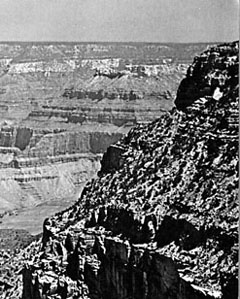
 |
de Steensplinter — Geology and a cosmology of the obvious | 3.2 introduction |
 The Coconino sandstone is the white band below the top of the section. (courtesy of USGS). notes 8 H. Moritz, `Science, Mind and the Universe, an introduction to natural philosophy', Wichmann, 1995. 9 J.M. Burgers, `Ervaring en conceptie, leven schept materie', Lochum Slaterus, Arnhem, 1956. Idem, `Experience and conceptual activity, a philosophical essay based upon the writings of A.N. Whitehead', MIT Press, 1965. 10 Burgers (1965, pages 9 & 10): "The typical notions of our thinking, the notion of value, the notions of purpose and of intention, of responsibility and of having a task, are observational facts, as real as the facts which physics has discovered in the relations between particles and fields. The two types of facts belong to different categories, which thus far appear to be unconnected. I do not believe that the idea of responsibility can be deduced from any formalism of physics, and I reject any world picture which puts this notion on a secondary plane. The two sets of features which we will call `conceptual' and `physical' undoubtedly must have relations to each other, and each part of our thinking will be intimately connected with physical occurrences. However, it is not possible that this is a connection which completely fits the present picture of physics. The best thing that we can do is to make use of a wider picture, and the conceptual and the physical features must find a place as complementary aspects of that wider picture." 11 E. Schrödinger, 'My view of the world', Cambridge UP, 1964. 12 As in D. Bohm, `Wholeness and the Implicate Order', Routledge, London, 1980, and in H.P. Stapp, `Mind, Matter and Quantum Mechanics', Springer, Berlin, 1993. previous (website version 2.30 - august 2007) |
introduction [continued] 1. introduction 2. continued 3. my proposal The exposition in Whitehead's books is not easy to follow. Helmut Moritz qualifies them in his Process and Reality (W2) as `difficult'. 8 The physicist J.M.Burgers has therefore published two books, one in Dutch, the second in English in which he purposes to elucidate Whitehead's texts. 9 In the second book he introduces a metaphysical scheme of his own, in which he defines `objects', including • facts and • forms of relatedness (forms of definiteness) and the `operation' conceptual activity . He writes: "Objects and operations in a metamathematical system are not defined by references to more basic notions, but must find their content in the relations assumed between them. They support one another through the connections expressed in their definitions." 9 Burgers' ideas have not met much attention. His books, for instance, are not included in Helmut Moritz's extensive list of books consulted. 8 Whitehead died in 1947. He was acquainted with relativity and quantum mechanics, but not with the resulting flight of theories. He does not mention the need for an original singularity, an idea first mentioned in 1931 in a private conversation between Hubble and Einstein. In the fifties Fred Hoyle, in a sarcastic mood, invented the name `Big Bang' for this singularity, but the name was apt and stuck. Since then physical philosophy has flowered and become a new period of abstractions: super-symmetry, string theory, loop quantum mechanics, etc., this time not borrowed from psychology but from physics. The trouble with these new physical/philosophical cosmologies is that they de-vitalize and de-spiritualize the universe. The idea of a universe, in which there is no room for the spiritual experiences of every man, is not satisfactory. Not satisfied were the physicists Schrödinger and Burgers. Burgers (1965) writes that the two sets of features, which we call `conceptual' and `physical' undoubtedly must have relations to each other, but that this is not a connection which completely fits the present picture of physics. 10 Schrödinger (1964) solves this problem by accepting the scholastic Vedânta vision, in which all things material are mere illusions. There is no plurality, only the spiritual One, the Brahman. 11 Both Whitehead and Burgers try to find room for the conceptual in all processes. Both also admit the importance of the evidence of what I will call `records' : the material evidence left by past processes and not by any processes that are still to come. Helmut Moritz 8 compares the two ways of looking at the universe in the following passages: (p. 219): "In fact modern physics tells us one lesson: many theories may be very far from `common sense' and still true, even unavoidable; think of special and general relativity, quantum theory, and modern elementary particle physics, which are all extremely abstract and `counterintuitive'. In comparison with these theories, Whitehead's `actual entities' are models of simplicity and common sense." And (p.230): "The monadic theory, artificial as it looks, has nevertheless influenced such diverse philosophers as Bertrand Russell and Alfred North Whitehead. Whitehead's `actual occasions' are interacting monads in space-time; his theory has proved surprisingly fruitful in quantum theory." 12 continued |
| © 2007 - uitgeverij de Steensplinter - All rights reserved |